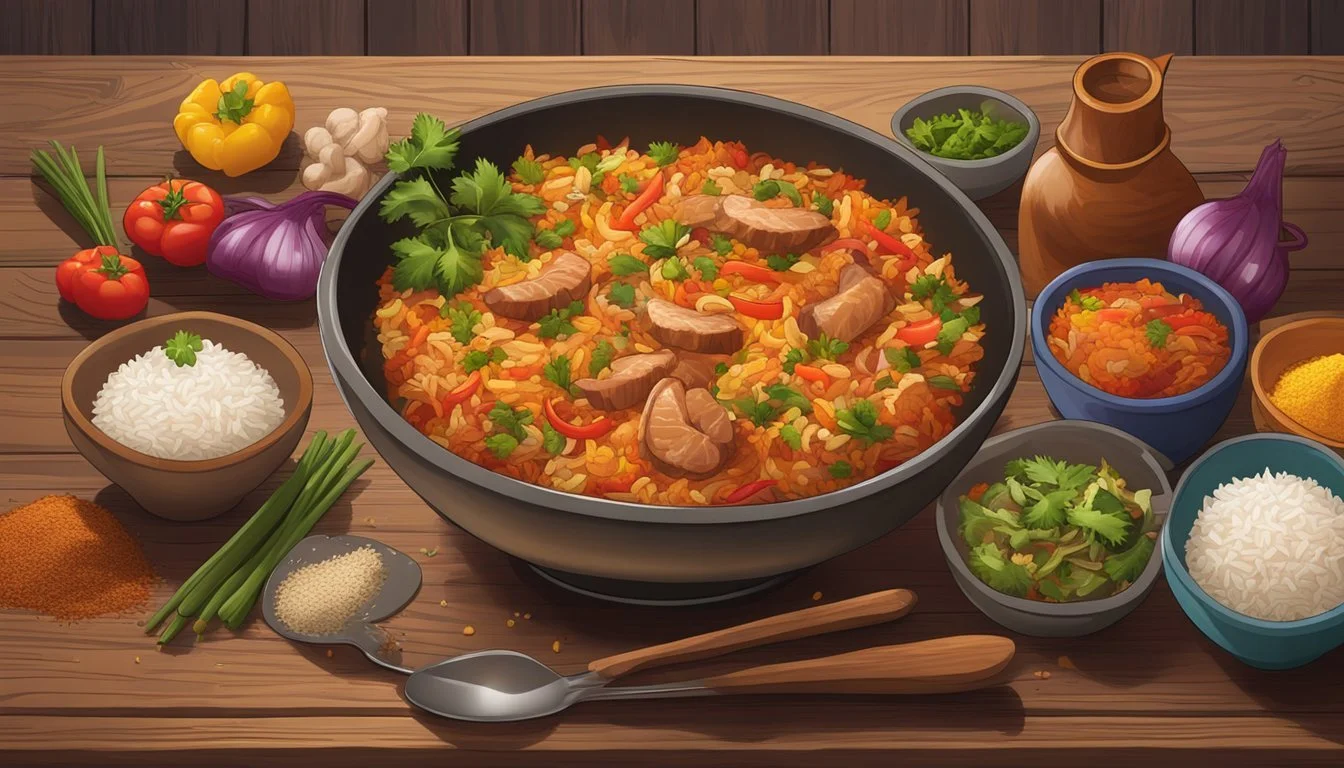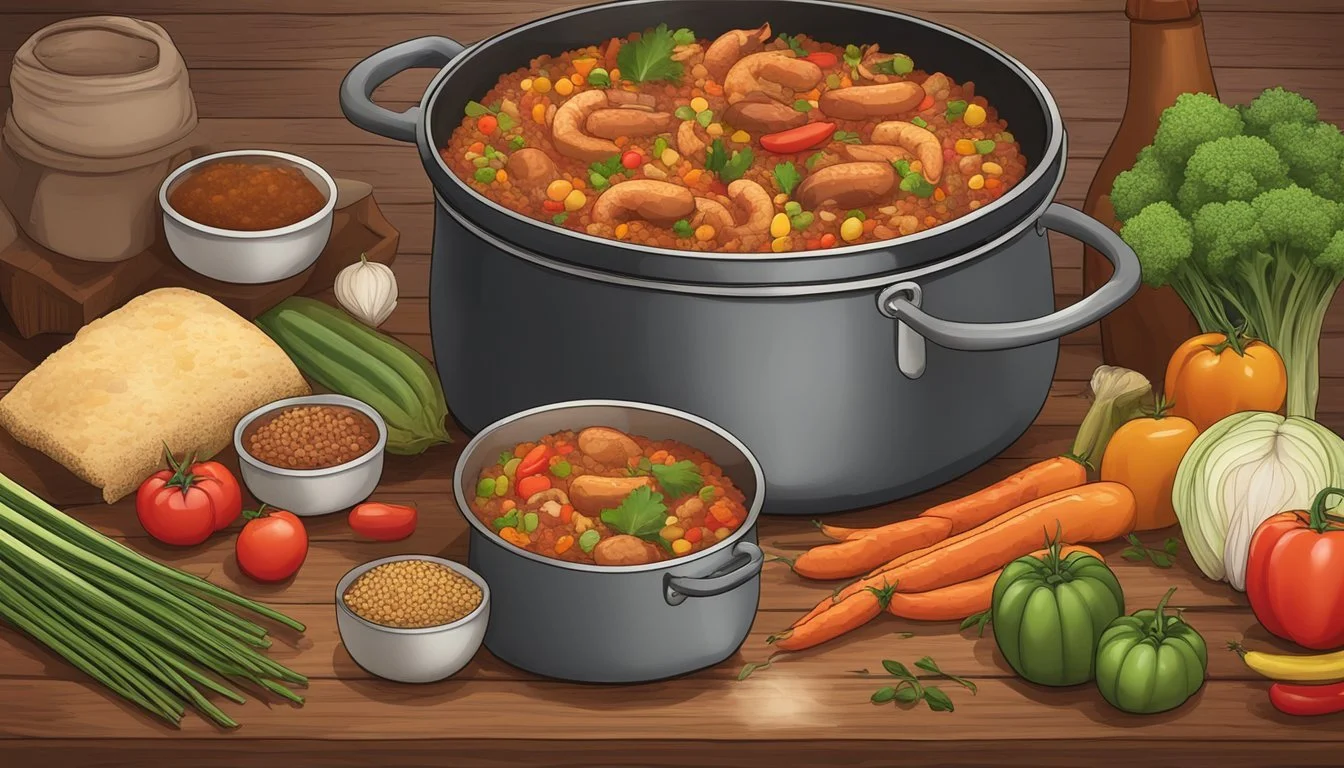How Do You Eat a Jambalaya?
Mastering the Southern Culinary Delight
Jambalaya is a quintessential Louisiana rice dish, steeped in both Cajun and Creole traditions, highlighting the cultural melting pot that is the heart of Southern cuisine. This hearty meal fuses Spanish, African, and French influences to create a complex flavor profile that is unmistakably Louisiana. Typically, it includes a variety of proteins such as chicken, sausage, shrimp, (What wine goes well with shrimp?) or other seafood, mixed with rice, vegetables, and a rich blend of spices.
Eating jambalaya is an experience that goes beyond mere consumption of food; it’s a celebration of a rich cultural heritage served in a bowl. Whether enjoyed at a local festival, a family gathering, or a quiet dinner at home, the dish is often a communal one, meant to be shared. The one-pot nature of jambalaya not only makes it a convenient and comforting meal but also allows the flavors of the ingredients to meld together beautifully, creating a symphony of taste in every bite.
In terms of preparation, both Cajun and Creole versions start with the "holy trinity" of onion, celery (how long does celery last?), and bell pepper, but differ in the use of tomatoes. Creole jambalaya, sometimes referred to as "red jambalaya", includes tomatoes, while the Cajun version does not, usually resulting in a "browner" dish. Regardless of the type, it's typically served directly from the pot it's cooked in, emphasizing its laid-back, rustic roots.
Understanding Jambalaya
Jambalaya is a traditional Louisiana dish steeped in history, embodying a blend of cultures and culinary practices. This hearty and flavorful meal presents variations that reflect its rich origins and the diverse communities of Louisiana.
Jambalaya Origins
Jambalaya traces its roots to Louisiana where it emerged from a combination of cultural influences including French, Spanish, and West African. Originating as a convenient one-pot meal, it combined local ingredients with cooking techniques from these varied culinary traditions. New Orleans often serves as a cultural beacon for this hearty dish, which has become a staple in the region.
Cajun vs. Creole Jambalaya
The two primary types of jambalaya, Cajun and Creole, differ mainly in the use of tomatoes.
Cajun Jambalaya: Originating from Louisiana's rural, low-lying swamps, this style does not include tomatoes. It features a brown appearance due to browning the meat and thus caramelizing the bottom of the pot before adding stock and rice.
Creole Jambalaya: Also known as "red jambalaya" and mostly found in and around New Orleans, Creole jambalaya includes tomatoes, giving the dish a reddish hue.
Basic Jambalaya Ingredients
The foundation of jambalaya includes what locals dub the "holy trinity" of celery, onion, and bell pepper. Proteins typically involve a combination of meats such as chicken, andouille sausage, and seafood like shrimp. Rice absorbs the rich flavors of the meat and the tomatoes (for Creole jambalaya), and the blend of seasonings adds complexity to the dish.
Rice: Long-grain white rice is the traditional choice.
Holy Trinity: Equal parts of celery, onions, and bell peppers (What wine goes well with bell peppers?).
Meat and Seafood: Chicken and andouille sausage are staples, with shrimp often added.
Seasonings: Include garlic, paprika, cayenne, and thyme.
This composition and variation underscore jambalaya's historical tapestry and its importance in Louisiana's culinary scene.
Jambalaya Cooking Techniques
Cooking jambalaya is an art that combines the right cookware, preparation of ingredients, and careful layering of flavors to create this traditional Louisiana dish. Mastery of these techniques results in a flavorful and hearty meal that perfectly blends rice, proteins, and seasonings.
Selecting the Right Cookware
Jambalaya is typically cooked in a dutch oven or a cast iron pot, essential for even heat distribution. The heavy build of these pots ensures that the dish cooks consistently, which is critical for the rice and proteins to reach the perfect texture.
Preparing Ingredients
Effective mise en place - the preparation and arranging of ingredients - is key for a seamless cooking experience. Chop celery, green bell pepper, and onion into uniform pieces for the holy trinity, the base of jambalaya. Measure out seasonings like Cajun or Creole seasoning, salt, black pepper, and cayenne for ready use.
Sautéing the Holy Trinity
Begin by heating a neutral or olive oil in the pot. Add the holy trinity - chopped celery, green bell pepper, and onion - and sauté until they are soft and aromatic, setting the foundational flavor. Garlic is often included at this stage for added depth.
Layering Flavors
Building layers of flavor is crucial. Incorporate seasonings like cayenne pepper, garlic powder, bay leaves, thyme, paprika, and oregano. Add tomato paste or diced tomatoes to introduce a rich, acidic note that complements the savory elements well.
Cooking Rice and Proteins
Stir in long-grain rice or basmati, ensuring it's well-coated with the base mixture. Add chicken thighs (What wine goes well with chicken thighs?), andouille sausage, or other proteins like pork, ham, or smoked sausage. Seafood such as shrimp or crawfish can be added later to avoid overcooking.
Simmering and Serving
Pour in chicken broth, stock, or water, ideally low-sodium, to cook the rice and proteins thoroughly. Cook on low heat, with the pot covered, until the rice is tender. For even cooking and to prevent sticking, occasionally give it a gentle stir. Serve the jambalaya hot once all elements are perfectly cooked and flavors melded.
Additional Jambalaya Variations
Jambalaya's versatility allows for numerous variations, catering to diverse palates and dietary preferences. From the type of proteins used to the level of heat in the dish, one can tailor this hearty meal to their taste.
Meat and Seafood Variations
Traditional jambalaya often features a robust combination of meat and seafood. Common selections include chicken and andouille sausage, which provide a savory base. For a touch of luxury, one could add shrimp, crawfish, or even oysters. Variations may also include other types of meat such as ham or rabbit for a different flavor profile. It's important not to overcrowd the dish and to consider cooking times for each protein to maintain the right texture and flavor balance.
Vegetarian and Vegan Options
For vegetarian and vegan variations, one can replace traditional proteins with meat substitutes like tempeh (What wine goes well with tempeh?) or tofu. One can also emphasize a variety of vegetables such as bell peppers, okra, tomatoes, and celery to round out the dish. The use of savory spices and fresh herbs is crucial to achieve the depth of flavor usually provided by the meat.
Spice Adjustments
Adjusting the spice level in jambalaya allows cooks to customize the dish's warmth to individual preferences. Spices like cayenne, black pepper, white pepper, and red pepper flakes can be modified to alter the heat intensity. For those who favor spicier dishes, adding hot sauce or increasing the amount of cayenne pepper can pack a punch, while others might opt for a milder dish with reduced spice content.
Serving and Pairing Jambalaya
Jambalaya's rich and hearty flavors make it a stand-alone dish, but certain sides and beverages can enhance the dining experience. Selecting the right accompaniments elevates the meal, marrying well with the dish's complexity.
Ideal Side Dishes
For a balanced meal, diners often choose lighter side dishes that complement the spicy and flavorful nature of jambalaya. Here are some commonly served options:
Cornbread: A sweet and tender cornbread can provide a comforting counterbalance to the spiciness of jambalaya.
Cheddar Biscuits: Fluffy biscuits with sharp cheddar baked in offer a savory, cheesy bite that pairs well with the entrée.
Crusty Bread: A simple slice of crusty bread is ideal for sopping up the flavorful sauce.
Green Salad: A crisp green salad dressed with a vinaigrette adds a refreshing touch to the meal, offering a palate cleanser between bites.
These sides are not only traditional but also provide a variety of textures and flavors that can complement the complexity of jambalaya.
Wine and Beverage Pairings
While jambalaya is often enjoyed with water or soft drinks, certain alcoholic beverages can accentuate its flavors:
Beer: A light lager or a pilsner can cleanse the palate without overpowering the meal.
Wine: When it comes to wine, a dry, crisp white, such as a Sauvignon Blanc, helps balance the richness and can cope with the spiciness.
It is crucial to consider the heat level of the jambalaya when selecting beverages, as some drinks can enhance or mitigate the spiciness.
Storing and Reheating
To maintain the quality of jambalaya, proper storage and reheating methods are essential. Not only do they preserve the flavors, but they also ensure food safety.
Proper Storage Techniques
Jambalaya should be stored in the refrigerator within two hours of cooking to prevent bacterial growth. It's best kept in an airtight container, which will keep it fresh for up to three to four days. For longer storage, one can freeze jambalaya; it will retain its quality for about two to three months. Before freezing, let the jambalaya cool to avoid raising the temperature in the freezer, which can affect other stored foods.
Reheating for Best Flavor
Reheating jambalaya requires gentle yet thorough heating to ensure that it reaches 165°F, the safe temperature for consumption.
Oven: An oven set to 350°F is a reliable method. Use an oven-safe dish, add a few tablespoons of broth or water to keep the jambalaya moist, cover it with foil, and heat it for 20-30 minutes.
Microwave: For a quick method, the microwave works well. Place the jambalaya in a microwave-safe container, add a splash of water to prevent drying, cover it loosely, and use a medium power setting to heat it in increments until thoroughly warm.
Stovetop: This method allows for closer monitoring. Heat the jambalaya over medium heat in a frying or saucepan, stir occasionally, and add a bit of liquid if necessary to prevent sticking or drying out.
Each reheating method should ensure the jambalaya remains moist and delicious, just like when it was first prepared.





